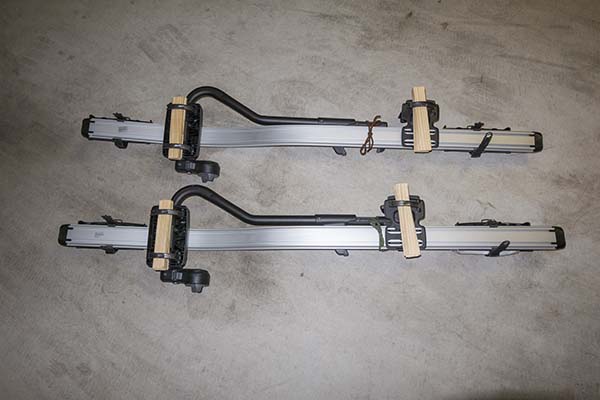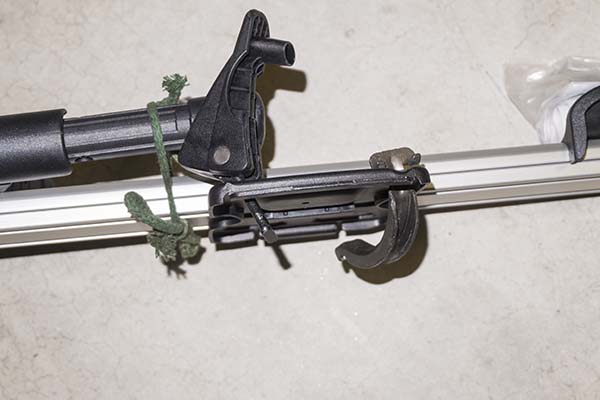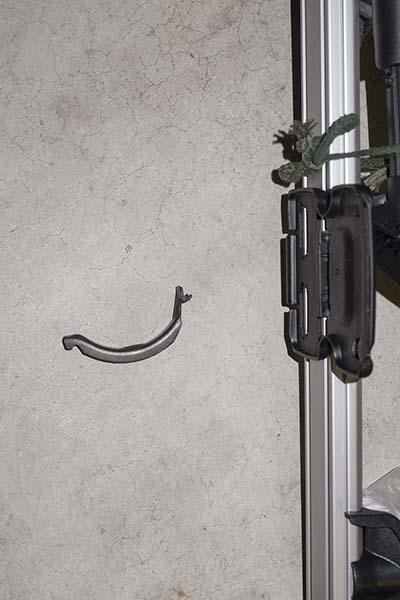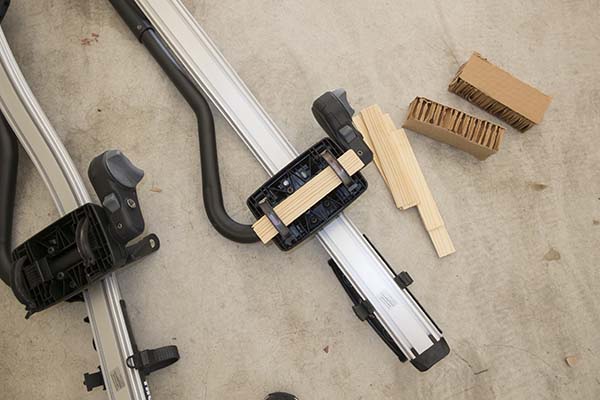Thule ProRide 591 (and presumably 598) — car top bicycle carriers — a brief review and caveat
© 2017 Peter Free
26 September 2017

Sweden's Thule ProRide 591 — and presumably its successor 598 — caveats
These roof-top bike carriers':
(a) parts-losing design (when off the car)
and
(b) their awkwardly unbalanced shapes —
(c) makes storage an unnecessarily time-consuming process.
Installed carrier function, however, works well.
Favorable reviews of the 591 and 598
How the 591 works is explained by James King, here on YouTube.
Representatively favorable reviews of the 591 and 598 include these:
Seb Stott and Cycling Plus, Thule ProRide 591 bike rack review: Benchmark rack that's quick and easy to fit, BikeRadar.com (17 November 2017)
Mat Brett, Thule ProRide 598, road.cc (28 June 2016)
Adam Kavanagh, The Modern Day Roof Rack from Thule, Bike Exchange (19 April 2016)
Ed Haythornthwaite, Thule 591 Proride Bike Carrier Review, Dirt (August 2011)
Not one of these overviews mentions — how parts-losing clumsy these racks are in storage
I have two 591s. Both bought unseen on the basis of favorable reviews:
Mine fall apart, unless one takes time-consuming measures to keep them intact. This is especially true, if you move homes a lot and (understandably unaware) movers have to pack them.
Second, the carrier's floppy bike frame arm flaps around when carrying the rack, unless one ties it down.
Third, carried vertically via either bike tire holder — as one occasionally might when trying to reach a high storage shelf — the holder slides right off the rail.
Fourth, the 591 refuses to reliably stand on either end, even when placed in a corner. The 591s and 598s are best put away on a shelf. Which is likely not the way that the majority of users are going to initially want to place them.
I found my pair of 591s so inelegantly silly off the car that I was repeatedly tempted to get rid of them.
Falling apart — specifics
Thule uses 2 pivoting bolts and curved metal clamps to attach each carrier to the vehicle's roof cross bars.
One end of the clamp portion of these metal assemblies is not attached to the plastic piece that holds it to the rack. Consequently, when the clamps are not in position on cross bars, they can (and often do) fall out of their plastic holders. Which means that you (or movers) will probably lose one or more, over the years.


When storing the 591s, I got into the habit of using a stack of wood shims to give the clamps something to keep everything in place. Having to do this on all four ends of my pair of 591s seemed unnecessarily time-consuming.

A better design would have secured the metal clamps to the carrier. This would have cost only a few cents and required some (evidently missing) common sense.
Similarly, if you carry the carrier vertically via either tire holder, the holder assembly will slide off the rail. The rail end caps are attached only by the coefficient of friction that holds them in place. No pins or bolts (equals) cheap and thoughtless.
Floppy bike frame holder arm
The bike frame holder arm pivots away from the carrier. When you pick the 591 up, with the arm facing downward — the arm flops into gravity's demanding embrace.
A simple rail-located catch would have made the 591 easier to carry. This would have cost only a few more cents and an equally tiny bit of foresight.
Ungainly, curved weight distribution
You will notice that the 591 and 598 are not flat. And most of the weight is concentrated at their front ends.
The combination of curved length and unequal weight distribution means that the 591 pretty consistently falls down, when stood on end.
It does not matter which end is down on the floor. Both plastic end pieces are slippery, as well as curved. They encourage toppling.
I doubt that squaring the rail caps would have made any difference at all to vehicle fuel economy. The caps are too small — and the combination of unaerodynamic carrier and bicycle too large in comparison — to impact miles per gallon or kilometers per liter.
This flaw is so predictable in its resulting clatter to the floor, that I wound up storing my pair of 591s flat. Which generally uses more space than desirable in tight quarters.
The moral? — If these design glitches do not matter to you, the 591 and 598 are good bike carriers
But since we PCS a lot, and generally live in houses that are pressed for storage space, the 591's off-the-car design seemed short-sighted. Enough so, to annoy.
 PeteFree.com
PeteFree.com